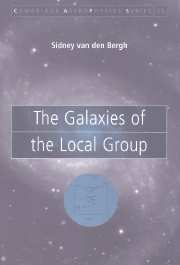Book contents
- Frontmatter
- Contents
- Preface
- 1 Introduction
- 2 Local Group membership
- 3 The Andromeda galaxy (M31)
- 4 The Milky Way system
- 5 The Triangulum galaxy (M33)
- 6 The Large Magellanic Cloud
- 7 The Small Magellanic Cloud
- 8 The elliptical galaxy M32 (= NGC 221)
- 9 The irregular dwarf galaxy NGC 6822
- 10 The starburst galaxy IC 10
- 11 Faint dwarf irregular galaxies
- 12 Spheroidal galaxies
- 13 The most luminous dwarf spheroidal galaxies
- 14 Dwarf spheroidals in the Andromeda subgroup
- 15 Faint dwarf spheroidals
- 16 The outer fringes of the Local Group
- 17 Intergalactic matter in the Local Group
- 18 Dynamical and physical evolution
- 19 Properties of the Local Group
- 20 Conclusions
- Glossary
- Bibliography
- Object Index
6 - The Large Magellanic Cloud
Published online by Cambridge University Press: 22 August 2009
- Frontmatter
- Contents
- Preface
- 1 Introduction
- 2 Local Group membership
- 3 The Andromeda galaxy (M31)
- 4 The Milky Way system
- 5 The Triangulum galaxy (M33)
- 6 The Large Magellanic Cloud
- 7 The Small Magellanic Cloud
- 8 The elliptical galaxy M32 (= NGC 221)
- 9 The irregular dwarf galaxy NGC 6822
- 10 The starburst galaxy IC 10
- 11 Faint dwarf irregular galaxies
- 12 Spheroidal galaxies
- 13 The most luminous dwarf spheroidal galaxies
- 14 Dwarf spheroidals in the Andromeda subgroup
- 15 Faint dwarf spheroidals
- 16 The outer fringes of the Local Group
- 17 Intergalactic matter in the Local Group
- 18 Dynamical and physical evolution
- 19 Properties of the Local Group
- 20 Conclusions
- Glossary
- Bibliography
- Object Index
Summary
Introduction
To the naked eye the Magellanic Clouds appear as detached portions of the Milky Way. They have probably been known to the inhabitants of the southern hemisphere for thousands of years. In the north the Large Cloudwas, like M31, already known to al-Sufi in the 10th Century. The Large Magellanic Cloud (see Table 6.1) is the largest and the brightest (external) galaxy in the sky. Because of this proximity (D ≈ 50 kpc), its stellar content can be studied in more detail than that of any other external galaxy. Observations that require a 5-m class telescope in M31 can be carried out with a 0.5-m telescope in the LMC. The Large Cloud belongs to the barred subtype of Hubble's irregular class. Its DDO classification is Ir III–IV [i.e., it has a morphology intermediate between that of giant (III) and subgiant (IV) galaxies]. Based on the presence of a faint streamer of nebulosity, which extends from α = 5h, δ = –73° to α = 3ḥ, δ = –55° (de Vaucouleurs 1954a,b, 1955), the Large Cloud xhas often been described as a late-type spiral. However (de Vaucouleurs & Freeman 1972), this spiral arm–like feature actually appears to be a faint streamer of Galactic foreground nebulosity. This feature in the constellation Mensa has also been observed in the infrared. From multicolor photometry and high-dispersion photometry of 38 stars in the vicinity of this filament Penprase et al. (1998) conclude that it produces a mean reddening E(B – V) ∼ 0.17 and is located at a distance of 230±30 pc.
- Type
- Chapter
- Information
- The Galaxies of the Local Group , pp. 92 - 141Publisher: Cambridge University PressPrint publication year: 2000
- 1
- Cited by

